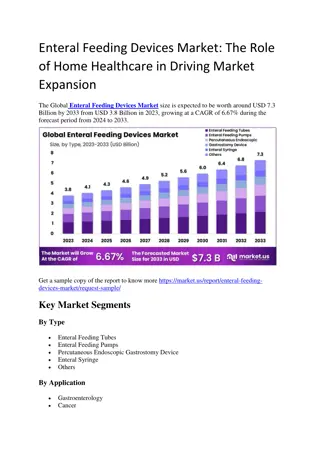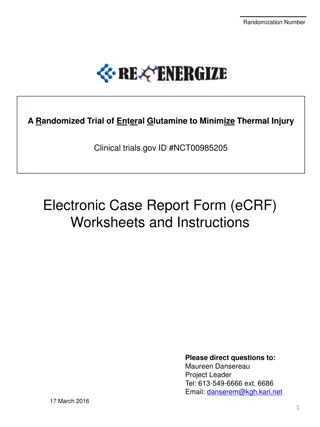Nutritional Therapy in the ICU: Enteral and Parenteral Nutrition Overview
Nutrition is crucial in ICU care to provide adequate calories and protein for patients. This involves enteral nutrition via tubes and parenteral nutrition through IV solutions. Enteral feeding should begin within 24-48 hours if the GI tract is functional, while parenteral nutrition includes dextrose, amino acids, electrolytes, and vitamins. Each method has its advantages, contraindications, and essential nutrients to support critically ill patients.
Download Presentation

Please find below an Image/Link to download the presentation.
The content on the website is provided AS IS for your information and personal use only. It may not be sold, licensed, or shared on other websites without obtaining consent from the author. Download presentation by click this link. If you encounter any issues during the download, it is possible that the publisher has removed the file from their server.
E N D
Presentation Transcript
L11 Anesthesia Technologist BCS. Anesthesia. and IC diploma. Community health Karrar Nader AL-Taie Anesthesia Technologist BCS. Anesthesia. and IC diploma. Community health Muneer Salman Hasan
Introduction Nutritional therapy is an integral part of ICU care. The goals are to provide adequate calories and protein to keep up with ongoing losses, prevent or correct nutrient deficiencies and promote wound healing and immune function.
two types of nutrition in the critically ill patient: 1. Enteral nutrition(EN) 2. Parenteral nutrition(PN)
Enteral nutrition(EN): Commence enteral feeding within 24-48 h of ICU admission if the gastrointestinal tract is functioning and patients have been adequately resuscitated. using a nasogastric or orogastric tube. Use 12FG in adult. confirm the correct position of the tube by any three of the following methods: (i) aspiration of gastric contents (ii) injection of 10-20 ml of air down the tube and auscultating the epigastricarea (iii) radiography.
Basic nutrients of EN water, carbohydrates, fat, proteins, electrolytes, vitamins, and trace elements. Vitamins are: B1, B6, B12, pantothenic acid, biotin, folate, vit. A, C, D, E, and K Trace elements: substances that present in the body in amounts less than 50 micrograms per gram of body tissue, and it is seven trace elements (chromium, copper, iodine, iron, manganese, selenium and zinc. EN either classical (made locally in special subunits inside the ICU) OR ready-made (comes premixed and ready to be given
Advantages of EN feeding: Less expensive Improved gut barrier function. Improved stimulation of blood flow of the intestine. Maintenance of gut immunologic function Contraindications of EN: Absolute: Shock Intestinal ischemia Complete intestinal obstruction Relative: Partial intestinal obstruction Severe diarrhea. Pancreatitis. High fistula
Parenteral nutrition(PN) Is an IV solution of 10-50% dextrose in water (CHO), amino acids, electrolytes, and additives (vitamins, minerals, and trace elements), Fat emulsions provide fatty acids and calories.
Basic nutrients of PN Solutions >10% dextrose must be infused via a central line. 1000 ml 5% D/W contains 50 g sugar= 200 calories 1000 ml 25% D/W contains 250 g sugar=1000 calories. Total calorie=30-40 cal/kg/day. Water: 30ml/kg/day. CHO: 60%. Fat: 40%. Ptn 1.2-1.5gm/kg/day. Na:1meq/kg/day K:2meq/kg/day
Dosage calculation Example: 80 kg male postoperative: Water: 30ml x 80 =2400 ml. Total caloric: 30 x 80 =2400 kcal. CHO = 2400 x60/100 =1440 kcal. Fat = 2400- 1440 = 960 kcal. Protein = 1.2 x 80 = 96 g/day Na = 1 x 80 = 80 mcg / day K = 2 x 80 =160 mcg / day Homework 60 kg male postoperative? 110 kg male postoperative
Indications Severe malnutrition. Burns. Bowel disorders (inflammatory disorders, total bowel obstruction, short bowel syndrome). Sever acute pancreatitis. Acute renal failure. Hepatic failure. Metastatic cancer. Post-operative major surgery if NPO > 5 days.
Complications Catheter related complications: Infections, sepsis, pneumothorax, hemothorax, arterial puncture, air embolism, arrhythmia. Metabolic complications: Hypoglycemia, hyperglycemia, hypokalemia/hyperkalemia, hyponatremia/hypernatremia, hypophosphatemia/hyperphosphatemia, hypocalcemia/hypercalcemia, hypomagnesemia/hypomagnesemia.
Monitoring for patients being given TPN Blood sugar: 4 hourly until stable. 6-12 h when stable. WBC count daily. Electrolytes daily. Renal function daily. Liver function, Ca, phosphate, plasma lipidemia weekly) Plasma albumin, transferrin(weekly). Urinary urea, trace elements, (alternative weeks). (twice























